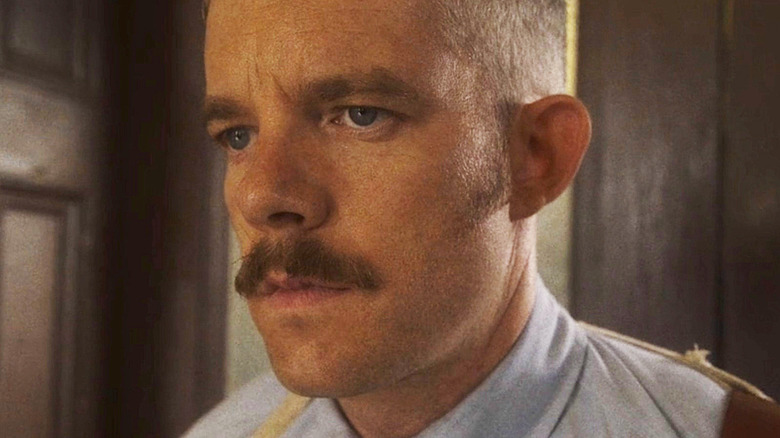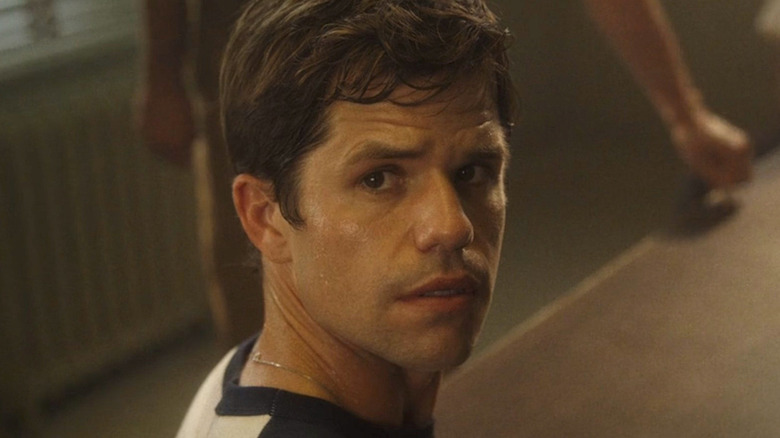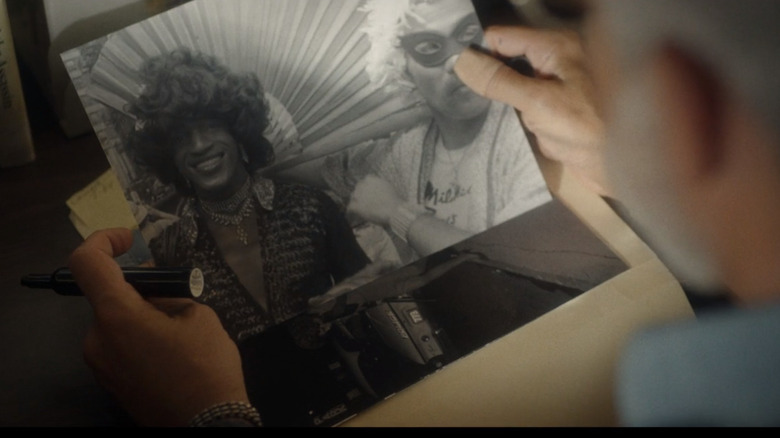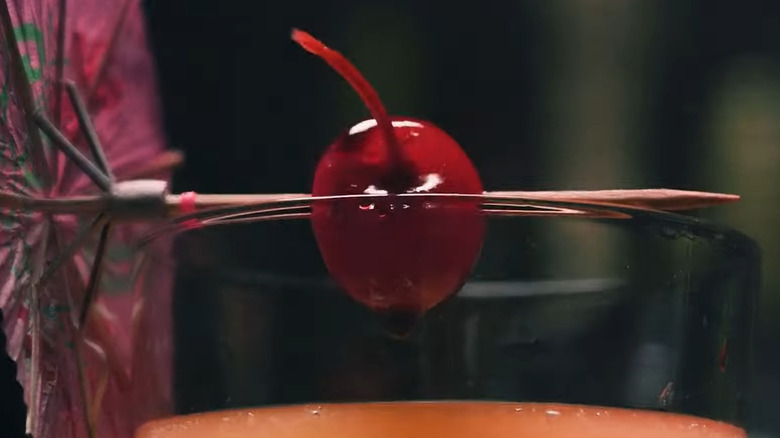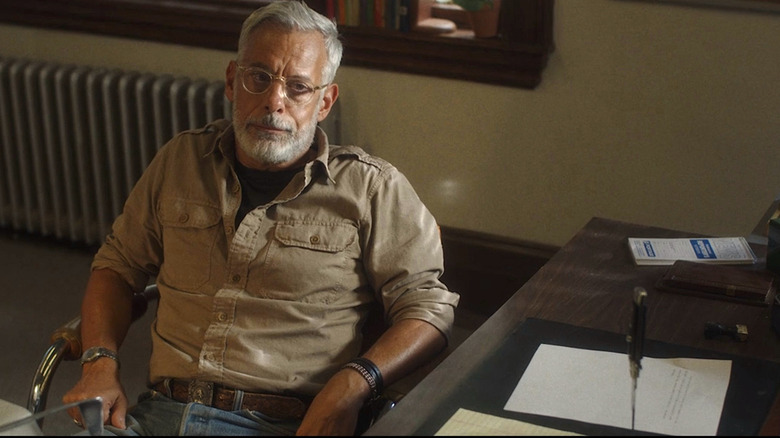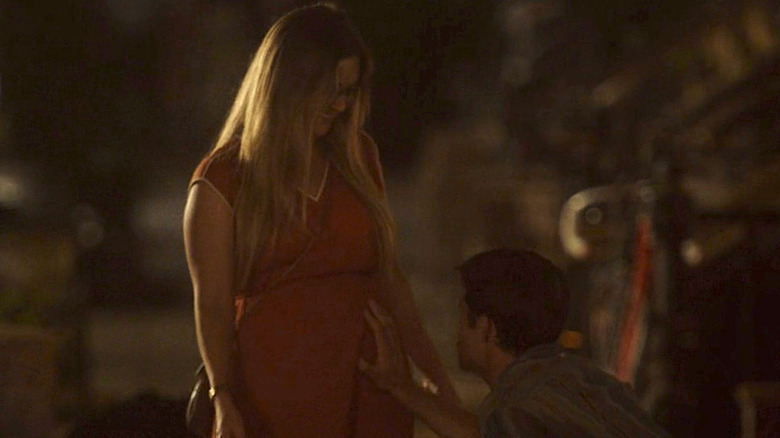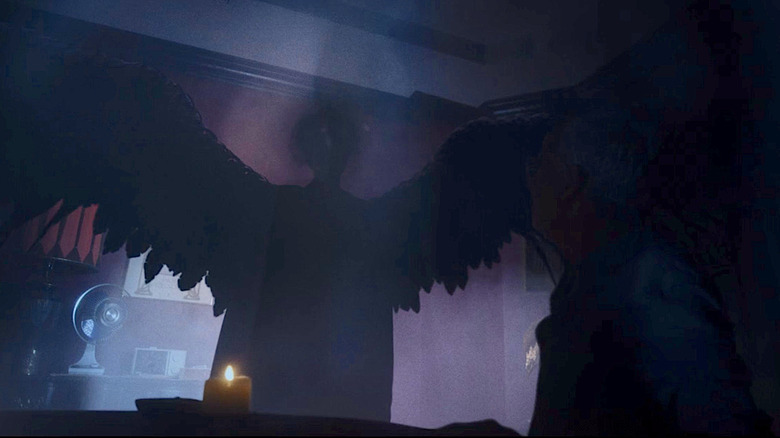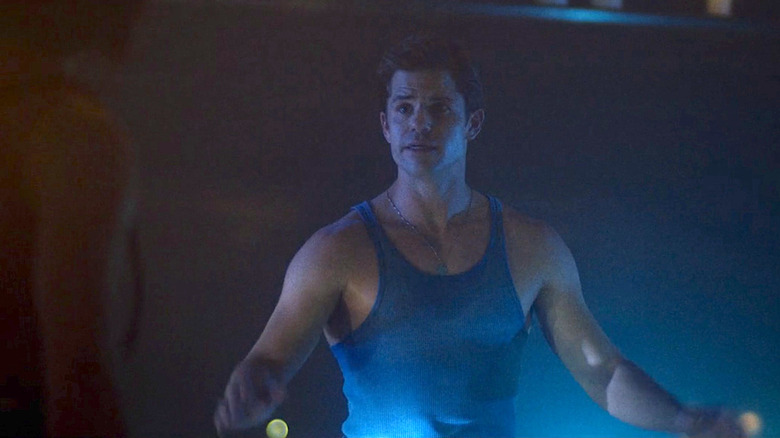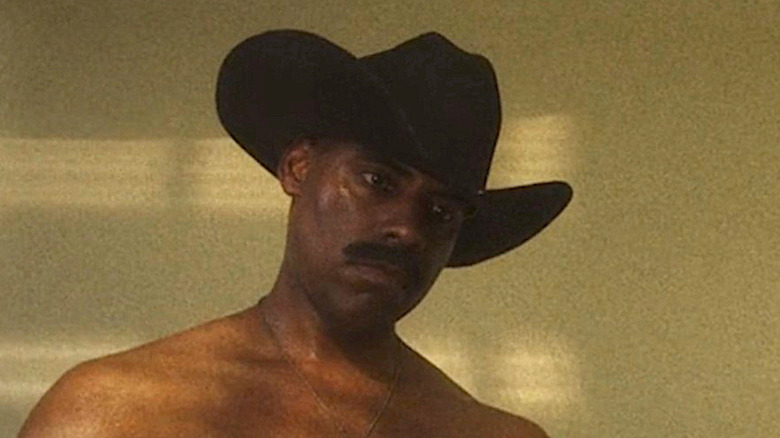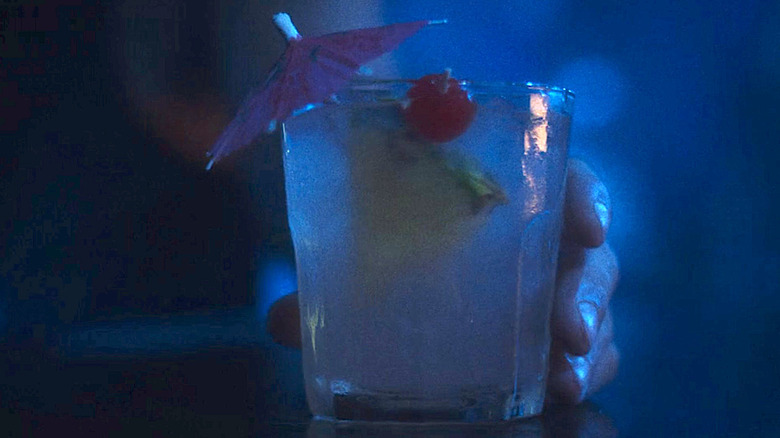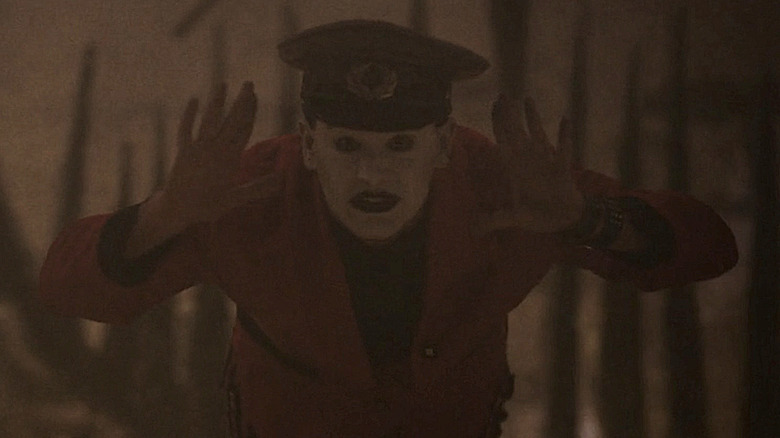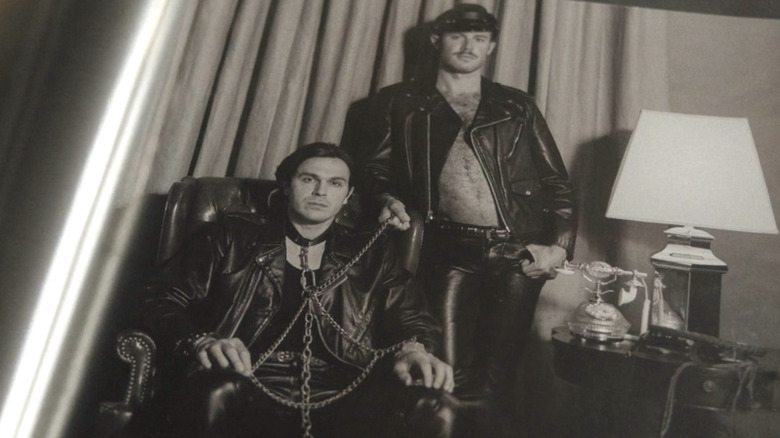Small Details You Missed In American Horror Story: NYC
If there's one thing "American Horror Story" is known for, it's taking big swings when it comes to the stories it tells. Every season of this horror anthology show, created by small screen luminaries Ryan Murphy and Brad Falchuk, revolves around a different horrifying premise, which is rooted in a unique setting. No matter the topic or place, however, you can always trust a season of "American Horror Story" to deluge the viewer with big themes, big drama, and from time to time, Big Daddys.
But deep inside this big, bold, and bloody horror storytelling lie many tiny and terrifying treasures. Just like Big Daddy is always lurking in the shadows of "American Horror Story: NYC," small details slink around the edges of every episode of the venerable series. These little touches are diverse in form and content. Sometimes, they take the form of Easter eggs that reference prior events in the show. Other times, they tip their hat to real-world history. As much of "American Horror Story" is inspired by actual history, this latter sort of detail is especially commonplace. The truth is often stranger (and a lot more disgusting) than fiction, after all.
These minute nods, references, and flourishes are easy to miss, but they bring richness to the series and an impressive degree of depth. "American Horror Story: NYC" is a particularly vivid example: This season is positively brimming with fascinating tidbits. Think you have the stomach to explore these little-known aspects of the beloved series? Then join us as we explore the small details you may have missed in "American Horror Story: NYC."
Charlie Carver pulls double duty as an actor and writer
Charlie Carver plays sweet and steadfast Adam Carpenter, one of the main heroes of "American Horror Story: NYC." You may recognize him from his work on "Teen Wolf," "The Leftovers," and Ryan Murphy's productions of "The Boys in the Band" and "Ratched." But what about his work behind the scenes? As only the most eagle-eyed viewers may have spotted in the "American Horror Story: NYC" credits, in addition to starring on this season of the spine-tingling series, Carver also helped write four of its episodes.
These episodes are Carver's first official writing credits, but they definitely don't seem likely to be his last. An out and proud gay actor since his pivotal 2016 Instagram coming-out post, Carver told The San Francisco Chronicle's Datebook section, "It's exciting to tell queer stories, both as an actor and as a writer/creator. But at the same time, I hope that, in now having played multiple queer characters — and with some of the scripts I've been working on offering different kinds of queer content — that what really happens is a breakdown of these sort of silos that we all put ourselves in." He went on to elaborate, "I think we've moved to a place where gay stories, queer stories, LGBTQ stories, they no longer have to feel sanitized."
If you're looking for the episodes Carver helped write, you can stop searching the dark park of the internet right now. According to IMDb, Carver contributed writing to "Thank You For Your Service," "Black Out," "Fire Island," and "Requiem 1981/1987: Part 2."
An iconic activist gets a quick cameo
"American Horror Story: NYC" shouts out a revolutionary activist in a blink-and-you'll-miss-it moment in Episode 2, "Thank You For Your Service." Gino Barelli, one of the show's main heroes, writes for trailblazing gay newspaper The Downtown Native, which takes obvious inspiration from the defunct publication The New York Native. When Gino is approving images for an upcoming issue, a particular photo catches his eye. It's a snapshot of the real-world transgender activist Marsha P. Johnson, who is smiling wide. "She's sweet," Gino intones, choosing her photo over several others. But sweet is only the half of it.
According to the New York Historical Society's "Women & the American Story" project, Marsha P. Johnson was a Black trans woman whose courageous activism made a major impact on history. A key participant in the legendary Stonewall uprising, she also founded the Street Transvestite Activist Revolutionaries with fellow activist and trans woman Sylvia Rivera. STAR provided many vulnerable young trans people with shelter, community, safety, and support.
While Johnson's death in 1992 was initially ruled a suicide, Johnson's fellow activists and friends believed she was the victim of an attack. In 2012, her case was reopened, and remains unsolved. No matter what, Johnson's memory lives on in her legacy of fearless advocacy, especially for trans youth of color. The quick glimpse of her offered in "American Horror Story: NYC" is a welcome tribute.
Keep your eye on the bouncing ball
Every season of "American Horror Story" has a killer credits sequence, and "American Horror Story: NYC" is no different. This sleek season opens with a kaleidoscopically disgusting display of cocktail umbrellas, bandanas, and bodies wrapped in leather. They all periodically morph into brandied cherries, mutating cells, BDSM gear, and that reliable old "American Horror Story" chestnut, creepily enormous deer.
At first, this credits sequence plays like a simple phantasmagoria of gore and fetish-wear. Such an amuse-bouche of oddities is common to Ryan Murphy's work. However, if you cast your investigative gaze past the flashy match cuts and bandanas shaped into cocktail umbrellas, you'll find tantalizing clues and intriguing Easter eggs buried just beneath the sequence's skin. One of them is downright bouncy.
The ball gag that gets bitten right at the sequence's end is symbolic of this series' relationship with sexuality, to be sure. But it's also a cheeky touch of foreshadowing when it comes to the method of the Mai Tai Killer's madness. Mr. Whitely explains to Patrick in Episode 7, "The Sentinel," that he uses them because he doesn't like hearing his victims scream in pain. Of course, Patrick never needs to use one for that purpose, even if "Velvet Touch" Henry does when he saws off his own hand. This allows him and Gino to escape, and Gino to save Patrick.
Matters of knife and death
Fran, one of the many colorful characters of "American Horror Story: NYC," is a tough-talking lesbian who can sort of read tarot cards and definitely read journalists the riot act. In Episode 1, "Something's Coming," Fran and her friends give Gino the business for failing to reflect issues that affect gay women in his supposedly gay-centric publication, The Downtown Native. While Gino blows the women off because he's too busy writing about gay men being hunted and killed, Fran gives him a switchblade as a gift of protection ... which she conveniently stabs into his desk.
This switchblade proves itself to be a pretty clutch item during Gino's fight for his life against Big Daddy in Episode 8, "Fire Island." While Gino doesn't land a killing blow (or honestly even a maiming one) in his life-or-death-tussle with everybody's favorite hulk from hell, he does manage to stab Big Daddy in the leg. This buys Gino enough time to scramble away into another room with Adam, where they enjoy safety for approximately 30 seconds. Then they're almost killed by Big Daddy again, until Patrick shows up to shoot the possibly-mystical maniac in the back of the head. One can almost imagine the fight the couple surely had about this later, with Patrick screaming about how he protected Gino and Gino screaming about how he was protecting himself. One thing is clear: Fran's switchblade is key to everyone's survival.
The mother of all homages
Adam Carpenter and Dr. Hannah Wells' friendship is truly charming. Hannah becomes more and more visibly pregnant as "American Horror Story: NYC" progresses, and eventually, we learn that Adam is the sperm donor. In another world, this show might follow the hijinks of such a charmingly unconventional family's attempt to raise a kid and make something of their lives in the Big Apple. But this is "American Horror Story," not "American Happy Story." The joy these two friends get to experience is not long for this world ... but it does reference a galaxy far, far away.
In Episode 5, "Bad Fortune," Adam makes a "Star Wars" reference that means more than you might think. While walking the city streets with Hannah, Adam affects the vocal stylings of the one and only Darth Vader and cracks a joke to her pregnant belly: "I am your father." It's a cute moment between these solidly doomed friends, and a solid reference to a pop culture touchstone. But that's not all it is. Hannah is played by Billie Lourd, daughter of the one and only Carrie Fisher, who played Princess Leia in "Star Wars." This fact makes the sweet moment into a touching homage.
Killing time with an old friend
Whether it's due to mysterious diseases, sex gone wrong, or old-fashioned serial killing, there is no shortage of death on "American Horror Story: NYC." Yet longtime fans of the series may still find themselves smiling at one of death's iterations, who appears as a freaky friend returning from afar. That's right: Season 2's Angel of Death, the strongest paranormal entity in "American Horror Story" history, makes a triumphant return in Episode 5, "Bad Fortune."
Always a bit of a lurker, Shachath has plenty to keep her busy in 1981 New York City. Though she usually only shows up when summoned or when she's ready to ferry souls to the other side, Gino sends the Angel packing — at least at first. The Angel appears to offer her services to Gino when he gets his terrible tarot cards read. While Gino is sick and tired of being sick and tired, he denies the solace Shachath wishes to provide in dramatic fashion. However sweet the taste, the Angel of Death's kiss is not on Gino's wish list.
Shachath is played by Frances Conroy in "American Horror Story: Asylum," but the role now belongs to Rebecca Dayan. Fans last saw her as a 1950s housewife possessed by aliens in "American Horror Story: Double Feature."
Interrupting a party to save the community
In "American Horror Story: NYC" Episode 4, "Black Out," Adam Carpenter makes a move bolder than any killer in the show: He interrupts a party to schedule a meeting. This meeting is likely inspired by a real-world one that had a major impact on life in New York City and the wider world.
In "Black Out," Adam and his new bartender friend Daniel are frustrated by the losses the gay community has been facing, due to multiple serial killers and a mysterious disease. Daniel is particularly affected by the death of Hans, a ballroom regular and frequent performer, who perished terribly and mysteriously. At a party, he castigates the crowd for being reckless — and Adam has his back. Adam begs the partygoers to help them find out what they're up against, and proposes a town hall meeting.
While this meeting never materializes in the world of "American Horror Story: NYC," the event that it might be based on absolutely did occur. According to the NYC LGBT Historic Sites Project, on August 11, 1981,trailblazing writer and activist Larry Kramer held a meeting at his house to address the earliest ripples of the AIDS crisis, then wreaking havoc in Greenwich Village. This raised a small amount of funds and helped kickstart the formation of Gay Men's Health Crisis, a key organization in the fight to help those affected by HIV/AIDS.
Notably, a 2014 production of Kramer's landmark play "The Normal Heart" starred Joe Mantello, the actor who plays Gino Barelli in "American Horror Story: NYC."
A slap-happy cowboy
When Adam goes to the press after the police do nothing to help him find his missing friend in Episode 2, "Thank You For Your Service," he doesn't expect to get slapped around by the cops for doing so. Furthermore, he definitely doesn't expect to be slapped around by a beefy man wearing little more than a scowl and a cowboy hat.
At first glance, this slap-happy cowboy seems like another typical Ryan Murphy flourish: He's a nonsensical, nearly naked, utterly random figure who comes with a heaping helping of camp. However, this offbeat interlude is actually a direct homage to an entirely different piece of media: William Friedkin's 1980 film "Cruising." Starring Al Pacino as a straight cop who goes undercover as a gay man to catch a killer targeting gay men in New York's S&M subculture, "Cruising" features an interrogation scene with — you guessed it — a random, slap-heavy appearance from a beefy man wearing nothing but a jock strap, scowl, and cowboy hat.
According to William Friedkin's "Cruising" commentary, this slap is based on urban legends surrounding unconventional police interrogation practices. Apparently, if precincts used something as extreme as a slapping cowboy, no one would believe anything their bullied victims had to say about any of their other methods of extracting confessions.
The Last Call Killer
"American Horror Story: NYC" is chock-full of killers, be they human beings or other biological baddies. Mr. Whitely, aka the Mai Tai Killer, seems like something straight out of a horror movie-induced fever dream, but in fact, he might be inspired by a very real murderer.
Whitely makes a meal out of drugging his victims with his cocktail of choice, then dismembers them with surgical precision. Driven by a twisted desire to create a hero for his community by destroying it, he wants to create a grisly Frankenstein's monster in time for Pride. Whitely strips his fellow gay men for parts to serve his grotesque mission, one that intensifies the longer his crimes are ignored by the police and the world at large. His real-life counterpart's crimes went just as ignored.
According to journalist Elon Green's "Last Call: A True Story of Love, Lust, and Murder in Queer New York," Richard Rogers, otherwise known as the Last Call Killer, preyed on gay men in piano bars. He went undetected for decades. Like Whitely, the Last Call Killer was a surgical nurse. His crimes proliferated in a world that was largely unaware of the threats against the gay community — or simply unconcerned with them. He was caught in 2001, when fingerprints on the bags he buried his victim's body parts in were identified using new technology.
Hans nods to a real-life superstar
Hans, the sweet and doomed performer who entertains the salon crowd in "American Horror Story: NYC," has a real-life inspiration: Operatic performance artist Klaus Nomi. According to Pitchfork, Nomi was originally from Germany. He lit up the New York art scene in the late '70s and early '80s with his eccentric look, distinct creativity, and extreme commitment to being gloriously weird.
While Nomi was overlooked by mainstream media during his life, his legacy has received more attention in recent years. As The New York Times points out, you can draw a straight line from Nomi's work to icons like David Bowie and Lady Gaga (who happens to star on "American Horror Story: Hotel"). Known for his intense eyebrows, theatrical hair, and a penchant for a black-and-white palette, Nomi got serious exposure when he sang backup for David Bowie on "Saturday Night Live," including a rendition of "The Man Who Sold The World."
Nomi's image gets new life in the form of Hans in "American Horror Story: NYC." Hans is clearly modeled on Nomi, from his look to his artistic inclinations. Though Nomi died in 1983 of complications from AIDS, this vivid reference proves his legacy is very much alive and well.
Theo's real-world roots
Theo Graves is a dreamy photographer who sometimes receives psychic visions when he isn't photographing men in the studio run by his villainous sometimes-boyfriend Sam. Theo's photography is very striking. It's also highly inspired by real-world photographer Robert Mapplethorpe.
Mapplethorpe's work is known for being sexually provocative, especially his portraits of New York's BDSM scene. But it's also rich with tenderness, tension, and love. The results are affecting, memorable, and sensitive — which also perfectly describes the work of the fictional Theo Graves. The fact that the latter character was inspired by the former artist is obvious, but even those who cottoned onto it immediately might not grasp the full depth of the reference. In a piece for The Guardian, writer and historian Jack Fritscher recalled self-portraits Mapplethorpe took wearing horns. The legendary photographer wrote to Fritscher, "I want to see the devil in us all." It's hard not to think of Theo Graves and the helping hands of his deer-boys when reading those lines.
